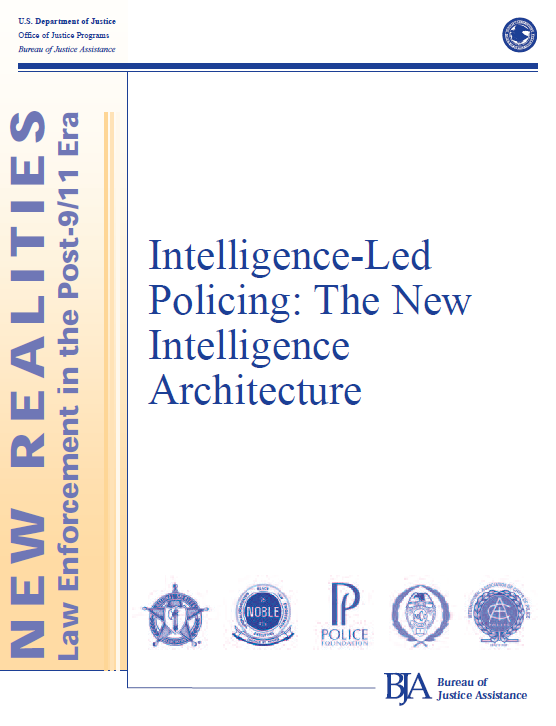 Bureau of Justice Assistance
Bureau of Justice Assistance
- 52 pages
- September 2005
Executive Summary
The terrorist attacks of September 11, 2001 revealed the life-and-death importance of enhancing U.S. intelligence operations. Since that day, a tremendous amount of attention has been focused on the need for constructive changes in law enforcement intelligence.
Intelligence operations have been reviewed, studied, and slowly but steadily transformed. Most efforts have focused on reorganizing intelligence infrastructures at the federal level; however, corresponding efforts have been made to enhance state and local law enforcement intelligence operations. Such enhancements make it possible for state and local law enforcement agencies to play a role in homeland security. Perhaps more important, improvements to intelligence operations help local law enforcement respond to “traditional” crimes more effectively.
Because effective intelligence operations can be applied equally well to terrorist threats and crimes in the community, homeland security and local crime prevention are not mutually exclusive. Officers “on the beat” are an excellent resource for gathering information on all kinds of potential threats and vulnerabilities. However, the intelligence operations of state and local law enforcement agencies often are plagued by a lack of policies, procedures, and training for gathering and assessing essential information.
To correct this problem, fundamental changes are needed in the way information is gathered, assessed, and redistributed. Traditional, hierarchical intelligence functions need to be reexamined and replaced with cooperative, fluid structures that can collect information and move intelligence to end users more quickly. Intelligence in today’s policing environment must adapt to the new realities presented by terrorism and conventional crimes.
These new realities require increased collaboration in information gathering and intelligence sharing. Critical community infrastructures such as those related to food, agriculture, public health, telecommunications, energy, transportation, and banking are now seen as potential terrorist targets. As a result, parts of the community that previously did not receive much notice from state and local law enforcement agencies now require keen attention. Personnel who work in these and other key industries are now partners in terrorism prevention and crime control. Similarly, community- and problem-oriented policing must be integrated into intelligence operations to address conventional crime issues. Engaging and collaborating with the community at all levels are essential.
Intelligence-led policing is a collaborative enterprise based on improved intelligence operations and community-oriented policing and problem solving, which the field has considered beneficial for many years. To implement intelligence-led policing, police organizations need to reevaluate their current policies and protocols. Intelligence must be incorporated into the planning process to reflect community problems
and issues. Information sharing must become a policy, not an informal practice. Most important, intelligence must be contingent on quality analysis of data. The development of analytical techniques, training, and technical assistance needs to be supported.Because of size and limited budgets, not all agencies can employ intelligence analysts or intelligence officers. Nonetheless, all law enforcement agencies have a role in the transformation of national intelligence operations. This document identifies four levels of intelligence capabilities for state and local agencies. At each level, steps can be taken to help agencies incorporate intelligence-led policing strategies. These steps include adopting mission statements, writing intelligence policies and procedures, participating in information sharing, establishing appropriate security, and adopting legal safeguards to protect the public’s privacy and civil liberties.
…
Contact information for each RISS center is as follows.
MAGLOCLEN
Middle Atlantic-Great Lakes Organized Crime
Law Enforcement Network
140 Terry Road, Suite 100
Newtown, PA 18940
www.info@magloclen.riss.netMOCIC
Mid-States Organized Crime Information Center
1610 East Sunshine Drive, Suite 100
Springfield, MO 65804
www.info@mocic.riss.netNESPIN
New England State Police Information Network
Grove Street, Suite 305
Franklin, MA 02038
www.info@nespin.riss.netRMIN
Rocky Mountain Information Network
2828 North Central Avenue, Suite 1000
Phoenix, AZ 85004
www.info@rmin.riss.netROCIC
Regional Organized Crime Information Center
545 Marriott Drive, Suite 850
Nashville, TN 37214
www.info@rocic.riss.netWSIN
Western States Information Network
1825 Bell Street, Suite 205
Sacramento, CA 92403
www.info@wisn.riss.net
